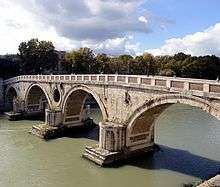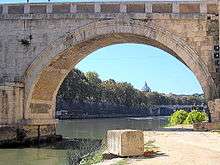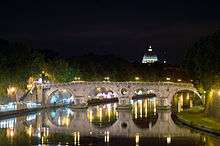Ponte Sisto

Ponte Sisto is a bridge in Rome's historic centre, spanning the river Tiber. It connects Via dei Pettinari in the Rione of Regola to Piazza Trilussa in Trastevere. The construction of the current bridge occurred between 1473 and 1479, and was commissioned by Pope Sixtus IV (r. 1471-84), after whom it is named, from the architect Baccio Pontelli, who reused the foundations of a prior Roman bridge, the Pons Aurelius, which had been destroyed during the early Middle Ages. Currently traffic on the bridge is restricted to pedestrians.
Roman Pons Aurelius
The predecessor bridge to Ponte Sisto, the Pons Aurelius, was first mentioned by authors in the 4th and 5th centuries and was later known in the Middle Ages as "Pons Antoninus", "Pons Antonini in Arenula", and "Pons Ianicularis id est pons ruptus vulgariter nominatus et Tremelus et Antoninus".[1]
The Pons Antoninus was partially destroyed in 772, at the time the Lombard king Desiderius took Rome, and rebuilt in its current form by Pope Sixtus IV, whose name it carries to this day.
Renaissance Ponte Sisto
The bridge is architecturally characteristic because of the circular "oculus" or eye lightening the masonry of its central spandrel: this was erected to diminish the river's pressure on the bridge in case of flood.
On the left bridge head are placed the copies of two marble slabs (removed in the 1990s after continued vandalism) bearing an elegant Latin inscription composed by Renaissance humanist Bartolomeo Platina in honour of Sixtus IV in occasion of the construction of the bridge. They recite:
- XYSTVS IIII PONT MAX
- AD VTILITATEM P RO PEREGRINAEQVE MVLTI
- TVDINIS AD JVBILAEVM VENTVRAE PONTEM
- HVNC QVEM MERITO RVPTVM VOCABANT A FVN
- DAMENTIS MAGNA CVRA ET IMPENSA RESTI
- TVIT XYSTVMQVE SVO DE NOMINE APPELLARI VOLVIT

and
- MCCCCLXXV
- QVI TRANSIS XYST QVARTI BENEFICIO
- DEVM ROGA VT PONTEFICEM OPTIMVM MAXI
- MVM DIV NOBIS SALVET AC SOSPITET BENE
- VALE QVISQVIS ES VBI HAEC PRECATVS
- FVERIS
On the corner of via dei Pettinari and via Giulia once stood a fountain, the mostra (display) of the Acqua Paola, a Roman aqueduct brought back to working order by Pope Paul V (r. 1605-21): the water was brought from Lake Bracciano to Trastevere and from there over the bridge to the Campo Marzio. The bridge still carries the water of the Acqua Paola across the river in eight large pipes.
Baroque and Modern age

On 20 August 1662, a brawl erupting between some Corsican soldiers controlling the bridge and Frenchmen belonging to the retinue of the French ambassador triggered the Corsican Guard Affair and had as effect the disbanding of the Corsican Guard, a corp of mercenaries originating from the island having police duties in Rome.[2]
After the Unification of Italy in 1870, the buildings surrounding the mostra dell'acqua paola were destroyed for the erection of the Lungotevere along the river side, and the fountain itself was relocated to Piazza Trilussa on the other side of the bridge, where it delivers water to this day.
In 1877, two large cast-iron pedestrian gangways resting on marble consoles were added to the sides of the bridge. After considerable controversies, Rome`s mayor Francesco Rutelli let them be demolished in 2000, restoring Ponte Sisto`s pristine silhouette, and since then traffic on the bridge has been restricted to pedestrians.
The Ponte Sisto connects the lively and popular Campo de' Fiori area (reached through via dei Pettinari) and via Giulia with Piazza Trilussa in Trastevere across the river, where many young Romans and tourists gather for an aperitivo on a Friday night.
Coordinates: 41°53′32.4″N 12°28′14.7″E / 41.892333°N 12.470750°E
References
Sources
- Ceccarelli, Giuseppe (Ceccarius) (1940). Strada Giulia (in Italian). Rome: Danesi.
External links
| Wikimedia Commons has media related to Ponte Sisto (Rome). |